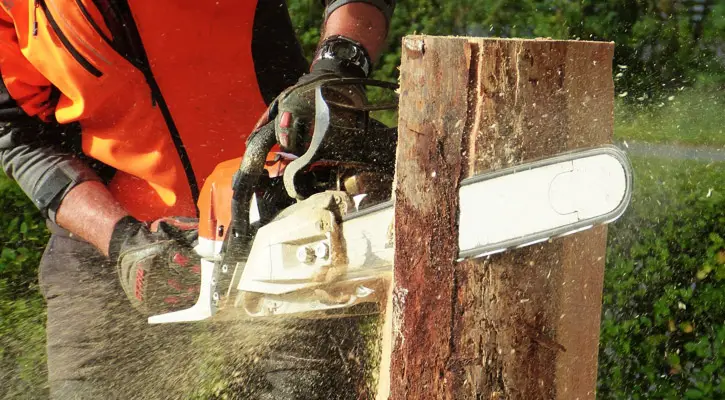Have you heard of a 4 cycle chainsaw?
How are they different than a 2 cycle chainsaw?
You might not know the ins and outs and the little intricate details about chainsaws. You know that yours works and gets the job done, and that’s all you need to know.
But many more minute features and attributes should be studied if you want to understand your chainsaw. Why do you need to know this? Because when you better understand the chainsaw that you own, the better you will be able to fix it, take care of it, make it last longer, and use it better.
And one of the things that you need to comprehend about your chainsaw is the engine that is used. An engine makes or breaks the chainsaw. If you lack a weak engine, your chainsaw will not work. If you have a powerful one, it will last for a long time and can cut down just about anything, no matter how big or strong.
Most gas-powered chainsaws use 2 cycle or 4 cycle chainsaw engines. Each has its pros and cons, advantages and disadvantages, and reasons why you should use them and why you should not. When deciding which chainsaw you want, you need to consider the type of engine that comes with it.
2 Cycle Chainsaw Vs 4 Cycle Chainsaw
Usually, motors that take a pre-mixed gas-oil combination are considered 2 cycle (also known as 2 strokes too) engines. Based on the motor, this combination, which may range from 50:1 to 20:1, provides the motor with fuel and lubricant while running.
Machines with four cycles, sometimes known as four-stroke engines, are more analogous to those you usually see in cars. Also, 4-stroke engines include a crankcase and an oil delivery system that maintains the oil and keeps it separate from the fuel while lubricating the engine parts simultaneously. Because the oil was separated, it must also be changed regularly, usually after 25 hours of usage.
Four cycles may utilize up to 10% ethanol and run using the same gasoline you purchase for your car. Therefore, they are easier to refill than two cycles because you can go to your local gas station and fill it.
The functioning of 2 cycle and 4 cycle chainsaw engines differs significantly. As one might anticipate, a 4 cycle motor operates in four phases. There is the power stroke, then the exhaust, the intake, then finally the compression stroke too. These four strokes are delivered throughout two complete revolutions.
There are just two cycles in a 2-cycle engine, which incorporate the aforementioned functions. The power and exhaust strokes are mixed in the first stroke, while the compressor and input strokes are mixed in the second. The piston’s apex of its stroke is when power and combustion occur. Exhaust and intake are located at the bottom. One revolution is all it takes to produce two strokes and move the piston throughout the whole cycle.
Using a 4 cycle chainsaw engine has quite a few benefits, but for the most part, 2-cycle motors are the norm. They are more dependable, less likely to break, and more straightforward to start and operate. Most experts suggest relying on the proven 2 cycle versions since the professionals do. However, a 4 cycle chainsaw may be the way to go for high torque concerns. It requires more work and expertise but will get the job done.
The sad fact is that numerous local regulations and laws currently seem to be influenced by the present state of the climate situation globally. Stricter pollution regulations may eventually eliminate 2 cycle chainsaws in the future. When that occurs, hopefully, manufacturers can advance 4-cycle technology and produce goods that function just as readily and conveniently as their 2 cycle equivalents.

The Differences
The comparison between a 2 cycle and 4 cycle chainsaw is not as straightforward as you may imagine. There are stark differences, but there are also subtle ones that are harder to pinpoint and realize.
For starters, 2 cycle engines typically are powered by pre-mixed fuel. This has the benefit of fueling the engine while also lubricating it at the same time too. This is great because it means that anyone using a 2 cycle chainsaw doesn’t have to have a separated oil reservoir.
Meanwhile, as we mentioned, a 4 cycle chainsaw runs like your car or truck. After about 25 hours, you will need to change the oil to ensure that your tool continues to work well. You can refill it when you need it with unleaded gas that you find at your gas station up the street.
Whether using a 2 or 4 cycle chainsaw, you need to be sure not to use E85 gas. It doesn’t work with either of those types of engines.
A 2 cycle chainsaw has fewer moving parts and sealed fuel storage. It also burns oil and creates more emissions. At the same time, it’s easier to start and weighs less.
The 4 cycle chainsaw has oil that needs to be changed more often and weighs more, but it is also more fuel-efficient and creates fewer emissions. In the future, the 4 cycle might be the only type of engine you can purchase due to regulations related to climate change and the environment.
In conclusion, A 2 cycle engine is more reliable and easier to use, which are huge bonuses. It is probably the right pick for someone who doesn’t have a lot of experience with chainsaws.
However, it also has some drawbacks, such as its environmental impact. If you have a 2 cycle chainsaw, you should enjoy it because it’s superior in many ways, including ease of use. But in the next few years, your chances of owning a 2 cycle chainsaw will be limited, if not completely gone.
Hope you found my article on 2 cycle and 4 cycle chainsaws helpful and knowledgeable.
Happy sawing!
Your pal,
Chainsaw Larry


